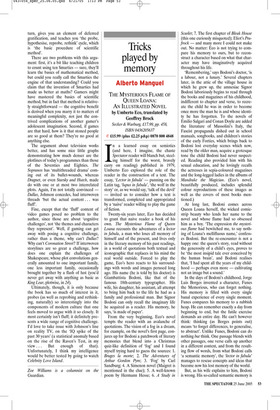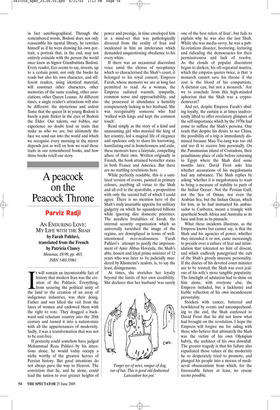Tricks played by memory
Alberto Manguel
THE MYSTERIOUS FLAME OF QUEEN LOANA: AN ILLUSTRATED NOVEL by Umberto Eco, translated by Geoffrey Brock Secker & Warburg, £17.99, pp. 458, ISBN 0436205637 ✆ £15.99 (plus £2.25 p&p) 0870 800 4848 In a learned essay on semiotics (and here, I imagine, the chaste Spectator reader will blanch but, steeling himself for the worst, bravely carry on reading) published in 1979, Umberto Eco explored the role of the reader in the construction of a text. The essay, ‘Lector in fabula’ — punning on the Latin tag, ‘lupus in fabula’, ‘the wolf in the story’ or, as we would say, ‘talk of the devil’ — invited us to consider how a text is transformed, completed and appropriated by a ‘naive’ reader willing to play the game of fiction.
Twenty-six years later, Eco has decided to grant that naive reader a book of his own. The Mysterious Flame of Queen Loana recounts the adventures of a lector in fabula, a man who loses all memory of himself and of the present, and lives only in the literary memory of his past readings, in a world of quotations both textual and iconographic that replaces in his mind the real world outside. Forced to play the game, Eco’s hero reacts to his surroundings with words and images perused long ago. His name (he is told by his doctor) is Giambattista Bodoni, like that of the famous 18th-century typographer. His wife, his daughter, his assistant, all attempt to bring him back to the life he had as a family and professional man. But Signor Bodoni can only recall the imaginary life he acquired as a reader. His memory, he says, ‘is made of paper’.
From the very beginning, Eco’s novel tempts the reader with an avalanche of quotations. The vision of a fog in a dream, for example, on the novel’s first page, conjures up for Bodoni a patchwork of literary memories that blend into a Christmas quiz-like definition of ‘fog’ and I found myself trying hard to guess the sources: 1. Bruges la morte; 2. The Adventures of Arthur Gordon Pym; 3. ‘Fog’ by Carl Sandburg; 4. A Simenon novel (Maigret is mentioned in the clue); 5. A well-known poem by Hermann Hesse; 6. A Study in Scarlet; 7. The first chapter of Bleak House (this one curiously misquoted); Eliot’s Prufrock — and many more I could not make out. No matter: Eco is not trying to compare his memory to ours, but to reconstruct a character based on what that character may have imaginatively acquired throughout his life.
‘Remembering,’ says Bodoni’s doctor, ‘is a labour, not a luxury.’ Several chapters later, in the attic of the village house in which he grew up, the amnesiac Signor Bodoni laboriously begins to read through the books and magazines of his childhood, indifferent to chapter and verse, to recreate the child he was in order to become once more the man he is and whose identity he has forgotten. To the novels of Emilio Salgari and Conan Doyle are added the literature of Mussolini’s Italy, the Fascist propaganda dished out in school manuals, songbooks, and children’s stories of the early Forties, which brings back to Bodoni lost everyday scenes which now, read by the older man, acquire a grotesque tone the child Bodoni had never suspected. Reading also provided him with his sexual education, and he lovingly recalls the actresses in sepia-coloured magazines and the long-legged ladies in the albums of Mandrake the Magician. (Eco’s novel, beautifully produced, includes splendid colour reproductions of these images as well as the covers of most books mentioned.) At long last, Bodoni comes across Queen Loana herself, the wicked comicstrip beauty who lends her name to the novel and whose flame had so obsessed him as a boy. ‘The expression the mysterious flame had bewitched me, to say nothing of Loana’s mellifluous name,’ confesses Bodoni. But the re-encounter is not a happy one: the queen’s story, read without the generosity of a child’s eyes, proves to be ‘the most insipid tale ever conceived by the human brain’, and Bodoni realises that, ‘I had spent all the years of my childhood — perhaps even more — cultivating not an image but a sound.’ In the days of Bodoni’s childhood, Jorge Luis Borges invented a character, Funes the Memorious, who can forget nothing. His memory is filled with every single banal experience of every single moment. Funes compares his memory to a rubbish heap. He can remember exactly a day from beginning to end, but the futile exercise demands an entire day. He can’t however think: thinking (as Borges points out) means ‘to forget differences, to generalise, to abstract’. Unlike Funes, Bodoni can do nothing but think. One passage blends with other passages, one verse calls up another in a different context, and from the resulting flow of words, from what Bodoni calls ‘a semantic memory’, the ‘lector in fabula’ manages to rescue concepts and ideas that become now his lost memory of the world.
But, as his wife explains to him, Bodoni is wrong. His so-called semantic memory is in fact autobiographical. Through the remembered words, Bodoni does not only reassemble his mental library, he rewrites himself as if he were drawing his own portrait, a portrait that, in the end, may not entirely coincide with the person the world once knew as Signor Giambattista Bodoni. Every reader, Eco seems to say, invents, up to a certain point, not only the books he reads but also his own character, and different readers, using identical material, will construct other characters, other memories of the same reading, other associations, other Queen Loanas. At different times, a single reader’s attractions will also be different: the mysterious and ardent flame that the queen lit in young Bodoni is barely a pale flicker in the eyes of Bodoni the Elder. Our talents, our foibles, our experience no doubt lend us traits that make us who we are, but ultimately the face we send out into the world and which we recognise every morning in the mirror depends just as well on how we read those traits in our remembered books, and how those books retell our story.



































































 Previous page
Previous page